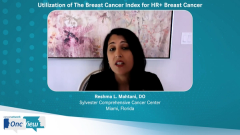
Genomic Testing for HR+ Breast Cancer: Best Practices
Dr Reshma L. Mahtani, of Sylvester Comprehensive Cancer Center, describes when and for whom she recommends genomic testing for HR+ breast cancer.
Episodes in this series

Kristie Kahl: When do you do genomic testing in your patients with hormone receptor–positive breast cancer? Do you test all of your patients? Why or why not?
Reshma L. Mahtani, DO: That’s a great question. It’s important to first recognize how far we’ve come. Many of us forget that not too long ago, we were giving chemotherapy to the majority of women with localized breast cancer, regardless of lymph node status, menopausal status, or receptor status. The availability of genomic assays to help us make that decision has allowed us to tailor our treatments much better and spare women the toxicities if they’re not benefiting from our treatments.
In my practice, I would order an assay only when the information will potentially change my decision. For example, in a patient with more than 3—some might say more than 2—positive nodes, I wouldn’t use the information. I would default to the use of chemotherapy. I wouldn’t send any assay in that situation. Similarly, it’s not useful to order the assay for a patient who is not suitable to receive chemotherapy, has multiple comorbidities, is receiving multiple other medications, or you don’t think will make it through chemotherapy without some significant toxicity. But for the patient for whom there’s some clinical equipoise—for example, a healthy pre- or postmenopausal woman with a clinically high-risk tumor, where the feeling really is to use chemotherapy—the results of a genomic assay can be very helpful in clarifying prognostic information. Most important, it helps us identify whether chemotherapy is likely to be a benefit and impact that risk.
Shifting to the decision about extended adjuvant endocrine therapy, if a patient is tolerating treatment well, has good bone density, is really committed to the decision to continue for the entire 10 years of therapy, and would be uncomfortable with the thought of going off-treatment, then I don’t know that I would order any assay. Unfortunately, not many of our patients are in that situation, because many of these women are suffering with adverse effects of these treatments. In my clinic, I frequently discuss how to manage the toxicities of endocrine therapy. We know that the information we would normally use to make that decision, namely clinical pathology factors, aren’t always reliable in predicting who’s going to benefit from continuing therapy. In terms of how I’m using these assays, I’m frequently using the Breast Cancer Index to make that extended adjuvant endocrine therapy decision.
Kristie Kahl: You just mentioned the Breast Cancer Index. How do you decide which assay to use for a given patient?
Reshma L. Mahtani, DO: It depends on what decision you’re trying to make. For patients for whom I’m making the decision regarding the use of chemotherapy, I’m typically using the 70-gene assay or the 21-gene recurrence score. Although there are certainly other assays that are available, those are the 2 that I’m most familiar with and comfortable using. That’s really the key: The physician has to feel comfortable explaining the results to the patient and making a difficult decision and conversation as easy as possible.
The NCCN [National Comprehensive Cancer Network] Guidelines detail where these assays are prognostic vs predictive. That information is certainly available to help guide physicians’ decision-making in terms of which assay to choose. The NCCN lists the 21-gene assay as the preferred, given the predictive and prognostic information that can be gleaned from it. But in my practice, although I recognize that MINDACT was not a study that was powered to identify a chemotherapy benefit, it has been useful in identifying a group of patients who have a sufficiently high distant metastasis-free survival that chemotherapy is not likely to improve that significantly. I’ve utilized the 70-gene assay quite frequently, and I’m very comfortable with that assay and having that discussion with the patient.
At my institution, we’re participating in the FLEX Registry. This registry utilizes MammaPrint and BluePrint. The study’s primary aim is to create a large-scale population-based registry of full genome expression data matched with clinical data to investigate new gene associations and prognostic and predictive value. We’re very excited about the possibility of interrogating that database, which will hopefully answer many questions. Finally, in terms of making that endocrine therapy decision of whether to extend, I’ve utilized the Breast Cancer Index quite a bit. This is an assay that’s been endorsed by NCCN and given the distinction that it’s the only 1 that provides predictive information on endocrine therapy benefit.
Transcript edited for clarity.
Newsletter
Stay up to date on recent advances in the multidisciplinary approach to cancer.












